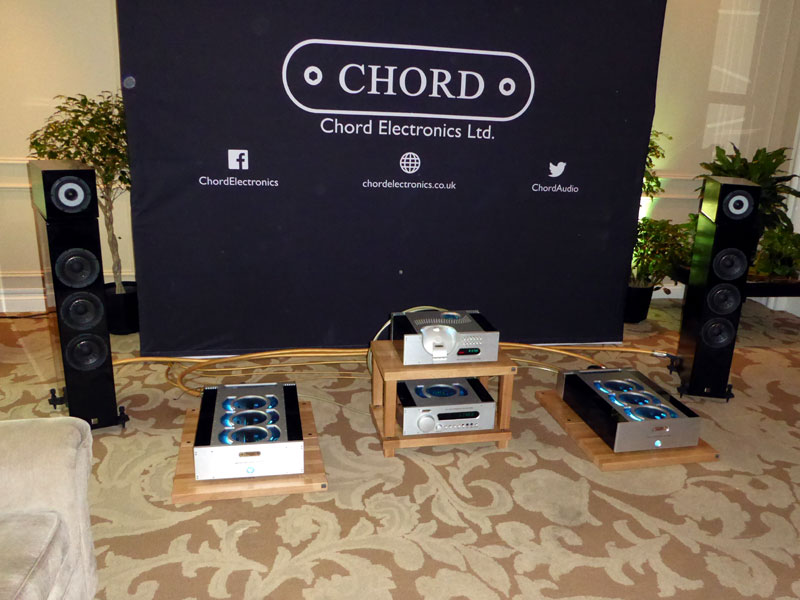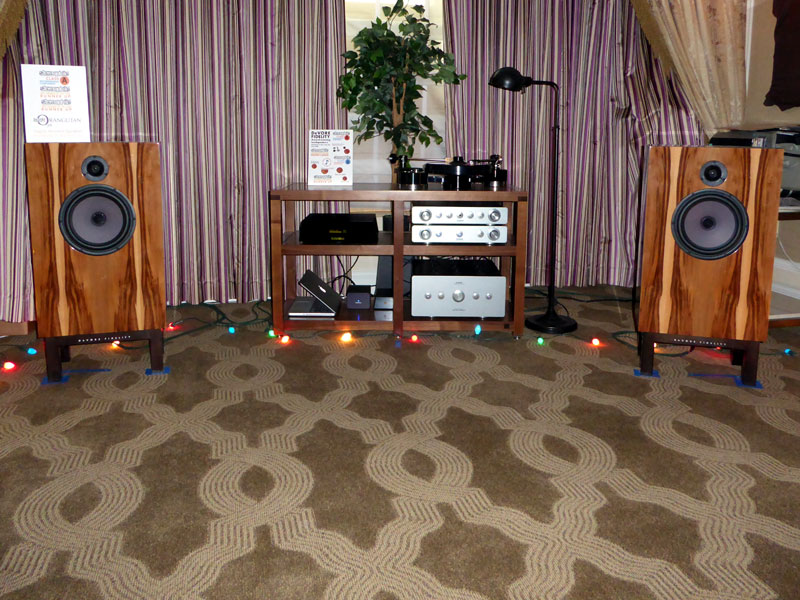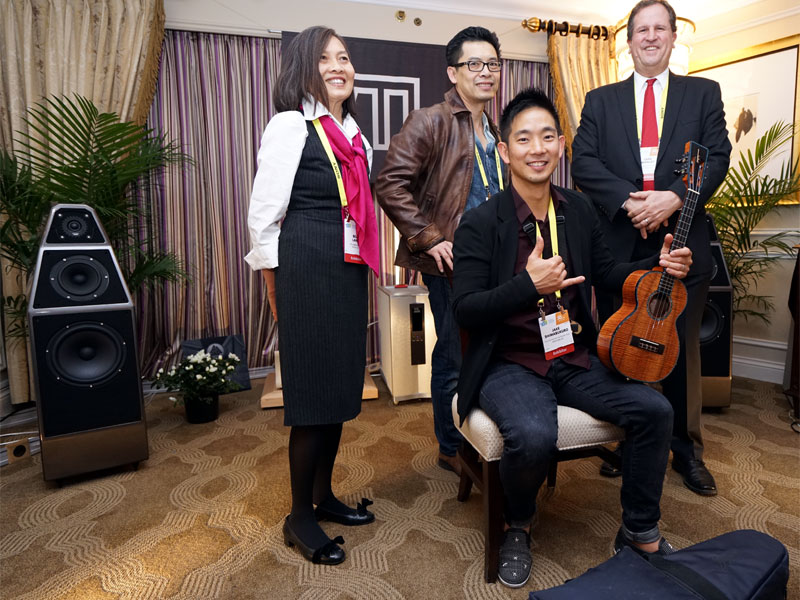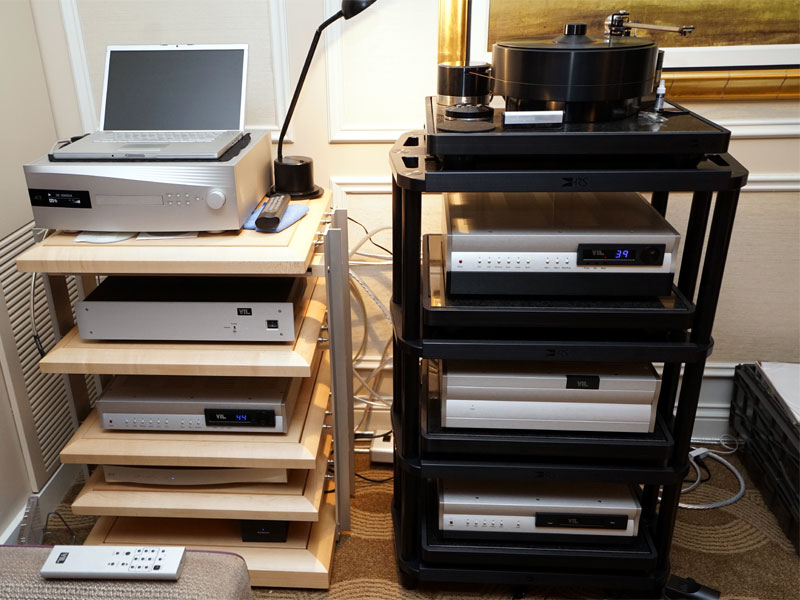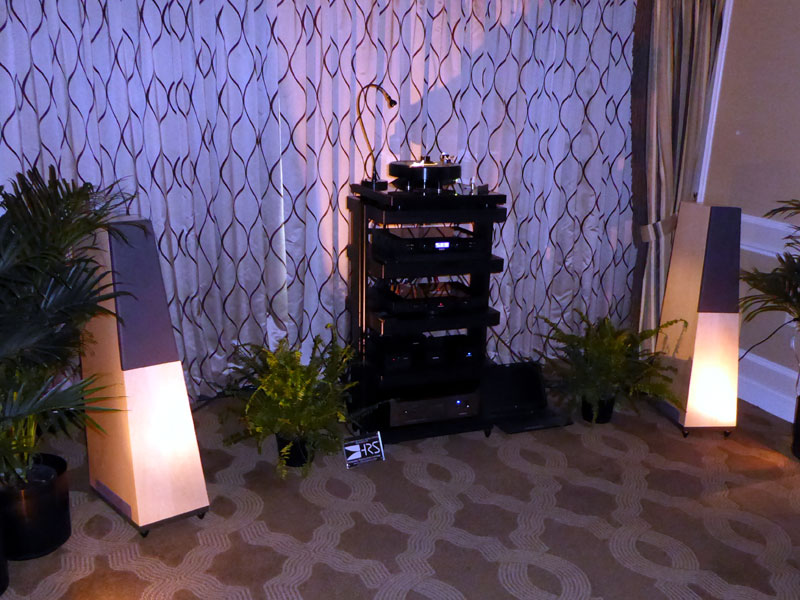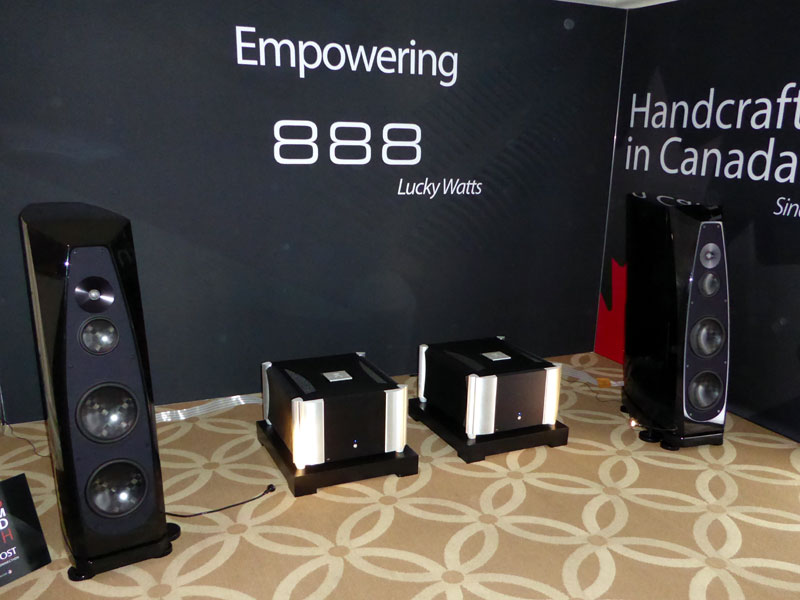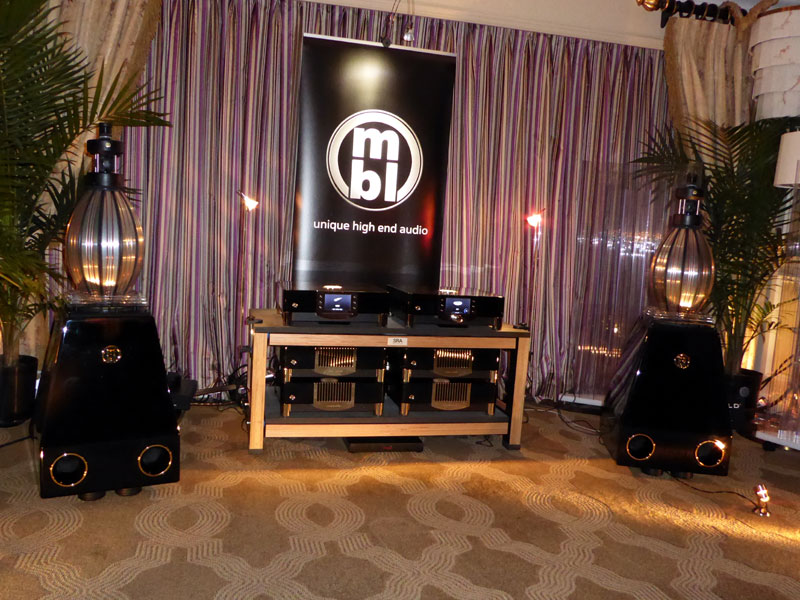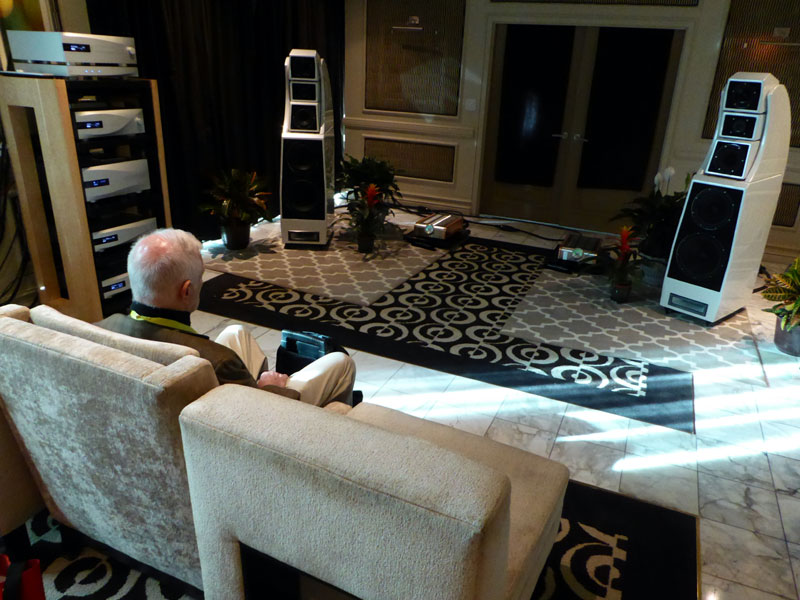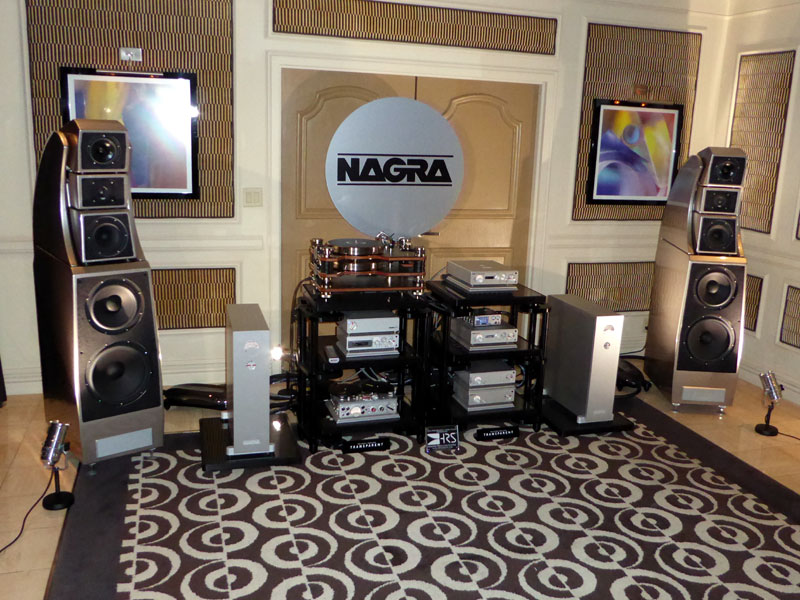Searching for Texture: The 2017 Jimmy Awards
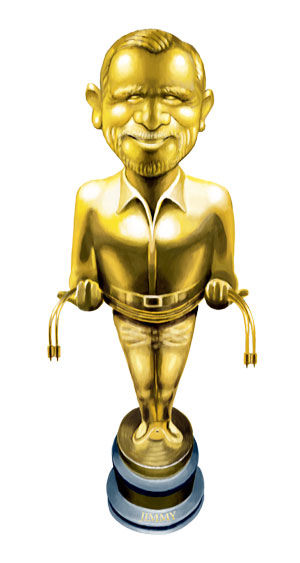 ithin minutes of my
landing in Las Vegas, Marc Mickelson rushed us over to a listening session arranged by
Harman International. It was an utter failure. The room was cramped, the music was horrid,
and the sound was glassy and hard. Marc used the word "glare" to describe the
ear-piercing emanations from a pair of new and improved loudspeakers. Never has a Consumer
Electronics Show started so dismally. ithin minutes of my
landing in Las Vegas, Marc Mickelson rushed us over to a listening session arranged by
Harman International. It was an utter failure. The room was cramped, the music was horrid,
and the sound was glassy and hard. Marc used the word "glare" to describe the
ear-piercing emanations from a pair of new and improved loudspeakers. Never has a Consumer
Electronics Show started so dismally.
The next morning, we were ensconced in an ample suite in the Mirage confronting a gigantic pair of Wilson Audio loudspeakers. Along the wall a daunting array of dCS products filled the shelves of a large rack. A pair of diminutive D’Agostino monaural amplifiers powered the system. Like a whipped dog, I almost cringed, expecting the sound of glare magnified to lethal extremes. Instead, the first track caused me to leap off the sofa shouting, "That’s it!" Tom Jones singing "What Good Am I?" was so realistic I could tell how old he was -- almost 77! To my ear, the sonorous sexuality of a youthful male voice has been replaced by a tinge of pathos -- even great singers eventually fade away. Such insight, whether true or not, derives from a system’s ability to unveil texture, defined as "how the melodic, rhythmic, and harmonic materials are combined in a composition, thus determining the overall quality of the sound in a piece." Yet even that dictionary definition is insufficient. Texture includes the microscopic details that breathe life into a recorded performance. Therein lies the day’s lesson. A stereo system that captures the breath of life is discerned by bodily reactions. The resulting thrills and goose bumps, even the desire to gesticulate, make the costly hi-fi hobby worthwhile. Yet, many industry designers who work hard to create works of electronic art can’t seem to tell when their products sound bad. So many systems filled their rooms with glare, the way the sun shines off a tin roof, rather than with texture, as a flickering lamp illuminates an oil painting. The sun-shiny demos simplified the music like a page of childish art, while the oil-painting rooms displayed the mature complexity of even simple songs. Those few exhibits that painted with a master’s brush are honored here. Rogue Audio is located in an Eastern Pennsylvania community so small (population 1627) that it’s not even a town but a "census designated area." As one enters the "area," a big sign proclaims "Entering Broadheadsville." As one drives by, the flip side reads, "Leaving Broadheadsville." (Just kidding.) Tiny town or no, the area inspires the design of best-value tube amplifiers. Although Rogue Audio has won Jimmy Awards at prior CESes, their 2017 system was their best ever for two reasons. First, the Rogue Audio RP-7 preamplifier ($4995) and Stereo 100 100Wpc power amplifier ($3495) were mated to the fabulously musical Joseph Audio Pulsar speakers ($7700/pair) via Darwin Audio Truth II speaker cables ($2995/8' pair) and Darwin Audio Truth II XLR interconnects ($1195/pair) and power cords ($1295 each). Second, a MacBook using Pure Music software streamed songs into an Ayre Acoustics QB-9 DSD DAC ($2500). The results were irresistible. For those to whom $25,000 is a pain in the wallet, a Rogue Audio/Darwin/Joseph Audio/Ayre system is sufficiently wretched excess, and it wins a Jimmy Award for High Fidelity for the Impecunious but Discriminating Audiophile.
Bluebird Music is a North American audio distributor. Their award-winning demonstration included Vienna Acoustics Liszt loudspeakers ($14,998/pair), Chord Electronics Red Reference CD player ($21,900), CPA 5000 preamplifier ($17,000) and SPM 6000 mono amplifiers ($41,000/pair), all lashed together with van den Hul Platinum interconnects and Cumulus 3T speaker wire ($19,000). If one prefers to stream his music, a DAVE DAC ($11,900) could replace the Red Reference CD player, saving a cool ten grand. The system reminded me of a custom-made suit -- subdued but elegant. Would the individual components sound as good as separates in any other system? Bluebird Music wouldn’t say. For selecting synergistic components to market, Bluebird Music enriches their trophy case with a Jimmy Award for Best Distributor of European Stereo Equipment at the Show.
Having spent my early working years in New York City, I have a warm feeling for people from Brooklyn. They are smart, sassy and self-reliant. At least one of the denizens builds great loudspeakers. John DeVore of DeVore Fidelity works at a Flushing Avenue address in Brooklyn. Although he lacks a Noo Yawk accent, he is fearless. No other manufacturer would dare play Earth, Wind and Fire on vinyl at the CES. I mean, the group is not audiophile approved. Yet, the horn-and-bass-line signature of America’s greatest funk group beckoned like a brazen lover. Listening to "That’s the Way of the World" recalled the hot summers of the ’70s and the unlimited future ahead. The retro look of the rectangular, two-driver Orangutan O/96 speaker ($12,000/pair), veneered in warm walnut, enhanced the moment. Ah, where has the time gone? Although the Orangutan’s whopping sensitivity of 96dB would suggest the use of a 5-watt single-ended tube amp, DeVore employed a muscular British solid-state amplifier, the Sugden AudioSapphire FBA800 stereo power amp (40Wpc, $7500) to spread a convincing soundfield. Other Sugden components included the Masterclass LA-4 preamplifier ($3750), and the Masterclass PA-4 phono stage ($2500). An EMT SD-75 MC cartridge ($2100) mated to an impressive-looking Brinkmann Spyder turntable with two armpods ($14,400) and Brinkmann 10.5 tonearm ($5490) captured the nostalgia of recalling funk in the city. DeVore generously lists other components as the Box Furniture Co. HD3W walnut double-wide three-shelf equipment stand ($5500) and Auditorium 23 RCA and XLR interconnects ($795/ meter pair) and speaker cables ($980/2.5m pair). Amazingly, the horn-like design was free of nasality. Consequently, DeVore Fidelity earns a Jimmy Award for Most Tonally Balanced High-Efficiency Loudspeakers at the CES. During my visit to the Joseph Audio room, I was appalled by the lack of foot traffic. The estimable Jeff Joseph opined that the 2017 show had more visitor peaks and valleys than other shows. I’ll say! In part the problem may have been that, unlike in prior years, Joseph Audio did not share a room with Bel Canto Design, makers of aurally pleasing class-D amplifiers. Traditionally, Bel Canto draws a crowd. However, Joseph Audio is nothing if not resourceful. They found an Ayre solution. A stack consisting of an Ayre Acoustics QX-5 Twenty digital hub ($8950), KX-R Twenty preamplifier ($27,500) and MX-R Twenty mono amplifiers ($29,500/pair) provided stunning motivation to Joseph Audio Pearl 3 speakers ($31,500/pair) via Cardas Clear Beyond speaker cables ($8668/2.5m pair) and interconnects ($3750/meter pair). The blooming synergy between Ayre and Joseph Audio may become a future fixture assuming high-end audio remains a segment of subsequent Consumer Electronic Shows. Joseph Audio/Ayre earns a JA for Most Promising New Pairing at the CES. At MSB Technology I encountered an old friend, Mark Markel, the guiding light of cable maker Analysis Plus. Mark’s recent absence from the high-end audio scene was due to a successful foray into the pro-audio market. For home stereo users of Analysis Plus cables, the return to the field of a fine gentlemen and great designer is good news. Despite the bustle around us, Mark graciously supplied a price list of the entire MSB array: MSB Technology M204 mono amplifiers ($39,950/pair), Select DAC II ($89,950) with Femto33 clock ($9950) and Select power supply mono bases ($19,995/pair), and Universal Medea Transport V ($6995) with Dual Signature transport power base ($4995). Cables included the new Analysis Plus Micro Golden Oval-In interconnects ($4995/pair), Golden Oval speaker cables ($19,400/4' pair) and Ultimate Power Oval power cord ($1795). MSB Technology employed YG Acoustics Sonja 1.2s ($73,400/pair), a transducer shown in at least two other demonstrations that, in my opinion, lacked the listening ease obtained by MSB. Played on this heavyweight system, Steely Dan’s "Babylon Sister" was detailed and dynamic with a slight splash from the high hat. After sixty seconds, the gentleman with remote control in hand suggested we switch over to MQA, the digital decoding technology developed by Meridian of the UK. Holy Calculus, Batman! Cymbals were cleaner, the soundfield wider and deeper. The chorus had a rounder prominence and the lead voice was free of hiss. The only negative was an obscuring of the drumsticks’ syncopation, as if the MQA cleanup process had scrubbed a little too close to the bone. Well, progress involves tradeoffs. Here are two thumbs up to MQA and a Jimmy Award to MSB Technology for Most Convincing A/B Demonstration at the CES. Robert Lee of Acoustic Zen asked a contemplative question, "If the speakers aren’t right, how can the rest of the system bring you joy?" Year after year, his Crescendo loudspeakers ($22,000/pair) bring me joy regardless of the electronics he uses. This year Acoustic Zen shared a room with British brand Questyle Audio, whose 200 System includes a 5gHZ wireless signal transmitter and two tiny 200-watt monaural amplifiers ($4500 set). Since wireless amps preempt the need for interconnects -- how nice -- Robert employed a minimal cable set of Acoustic Zen Absolute 75 coax digital cable ($498/meter length) and Hologram speaker cables ($1248/8' pair). Only a designer of altruistic intent would use fewer rather than more of his company’s cables. Mr. Lee has written a meticulous white paper to explain his loudspeaker’s preternatural clarity and openness. His design brief includes extreme phase accuracy and an almost resistive load for the amplifier to see. These requirements are easier said than met. The practical result of single-minded zealousness is a hazeless sound that calms the mind, independent of the electronics’ pedigree. Despite tough competition from a host of big names, the Acoustic Zen Crescendo claims a Jimmy for Most Perfect Loudspeaker Output at the CES.
Luke Manley and Bea Lam of VTL enjoyed an embarrassment of riches. Not only was the VTL room full of visitors, but they also had a live music performance on hand. Professional ukulele player Jake Shimabukuro entertained with his own rendition of the Beatles’ "Eleanor Rigby." Although the experience showed there is no substitute for live music, I personally would have liked more inner detail.
Thankfully, VTL filled the bill with a scintillating long-play recording of Frank Sinatra. The Nelson Riddle Orchestra performed the music and a youngish Sinatra conveyed the hopefulness replete within "Blue Moon." A Brinkmann Balance turntable with 12.1 'arm ($27,490) RoNt power supply ($4190) and Lyra Etna cartridge ($8995) extracted every nuance of Sinatra’s light baritone (in 1961 before all the smoking deepened his voice). VTL amplification did the heavy lifting. A TL-7.5 Series III Reference preamplifier ($25,000) and TP-2.5 phono stage ($3750) fed an S-400 Series II Reference stereo amplifier ($33,500) that drove a pair of Wilson Audio Yvette loudspeakers ($25,500/pair) to heights of ecstasy. Nordost Odin 2 signal cables and power cords were used throughout along with their QB8 Base Mk 2 power conditioner. Despite following a live act, the ethereal presentation across time and space of a legendary singer was sublime. With only a modicum of ticks and pops, Old Blue Eyes was in the room! A Jimmy Award goes to VTL for the Best Vinyl System at the CES.
Even after four decades, loudspeaker designer Richard Vandersteen does not rest on his laurels. In fact, he’s now building his own drivers. The Vandersteen Quatro Wood CT speakers ($13,900/pair) may be the best famous-name transducer value in hi-fi. Despite their diminutive footprint, the Quatro Wood CTs float a lifelike image, a Vandersteen specialty. Listening to Johnny Cash sing "Rose of My Heart" on vinyl gave me pause to reflect. This was the second system that revealed a singing icon’s crinkley old-man voice. At the time of the recording, Johnny Cash was my age and died soon after, but it worries me not. He lived a lot harder than I -- maybe [gulp]. Vandersteen’s sources and electronics consisted of Brinkmann components: Bardo turntable/10.0 tonearm ($9990), Pi Cartridge ($2490), Fein phono stage ($3100), Nyquist DAC ($18,000) and Brinkmann integrated amp ($7200). It’s worth noting that three systems won awards using Brinkmann products. Hard-core hobbyists might want to check out this German manufacturer’s wares. Vandersteen also credited HRS RXR stands ($6210), four R-Series 1921 bases ($494 each) and a custom M3X-1921 base for the Bardo ($2895). Power and cabling were provided by AudioQuest, including the Niagra 7000 power conditioner ($7995). The first pair of hi-fi speakers I ever purchased were Vandersteen 2Bs. If I had just traded up within the Vandersteen line over the past 37 years, I’d have a great system today, along with money in the bank. Vandersteen Audio, with the Quatro Wood CT, takes home yet another award for Best Richard Vandersteen Design at the CES.
For those who’ve salted away $118,000 and can hold on to it until the second quarter of 2017, Moon by Simaudio has an amplifier in the production queue just for you. The Moon 888 Extreme Reference mono amplifier ($118,888/pair) can output up to 888 watts into 8 ohms. The 56 transistors per side are custom made by Motorola, an extreme design advantage. However, bookish audiophiles need not apply, nor for that matter champion weightlifters. Despite weighing 250 pounds, this behemoth comes without any way to grab it for lifting purposes. Pity the poor reviewer who is home alone when two giant crates arrive. Besides the 888, Simaudio had other reference gear on hand, albeit not Extreme Reference. The Moon 780D streaming DAC ($15,000) with 820S power supply ($8000) decoded the music selection. The Moon 850P preamplifier ($30,000) transferred the signal from the DAC. Rockport Technology Cygnus loudspeakers ($62,500/pair) handled the 888s' output with ease. About $60,000 worth of Nordost Valhalla 2 cables tied all six pieces together. Despite its sound-reinforcement specs, the Moon 888 displayed a tubelike delicacy at low volume. Dire Straits' "Love over Gold" conveyed startling chord changes at 80dB. Nevertheless, stifling an urge to blow out the hotel’s windows was a pressing chore. For Most Daunting New Product at the CES, Simaudio wins a 250-pound Jimmy. Come pick it up.
In former years, I could not warm to the sound of mbl’s highly regarded omnidirectional loudspeakers. It seemed to me that the presentation, while vanishingly low in distortion, was too far rearward from the plane of the speakers. The depth of image seemed artificial, as if I were watching A Midsummer Night’s Dream from the veranda while the performers were cavorting on the other side of the swimming pool. This extreme depth of image seemed to me a distortion from reality; mbl enthusiasts disagreed. But it now appears that the company’s engineers took my misgivings to heart. With the introduction of mbl’s new Noble line of electronics, the mbl system now projects 3D images within the room instead of floating in faux space a long distance away. The result is as captivating as the old portrayal but now immediate and tactile. The N-series components have enabled the realization of the mbl dream. While the attainment of realistic perspective does not come cheap, the cost of the entire mbl package is reasonable by reference standards: Radialstrahler 101E Mk II loudspeakers ($70,500/pair), N11 preamplifier ($14,600), N15 mono amplifier ($17,800 each, four used), and the luscious N31 DAC/CD player ($15,400). Moreover, MSB’s cable selection seriously economizes this incredible system. Wireworld Eclipse Series 7 interconnects ($450/meter pair) and speaker cables ($1550/meter pair) were right at home here, as was mbl’s own PC2 power cords ($950 each) A Silent Running Audio ScuttleČ ($7000) housed the electronics, proving that good racks cost money, but please note the disparity between the low cost of Wireworld Eclipse cables and the prices of other brands used in prize-winning systems. If a system can garner an award for Best Sound at the Show linked up with Wireworld, why, may I ask, should anyone invest six figures in cabling? In case the reader missed the off-handed remark, here it is again. The Jimmy Award for Best Sound at the Show goes to mbl.
Yet, the awards show isn’t over. Having painted myself into a corner, I must now escape without making a mess. That’s because two demonstrations that featured the same Wilson Audio Alexx loudspeakers ($109,000/pair) continue to haunt me weeks after the show. At the dCS demonstration mentioned early on in this report, the Vivaldi 2.0 four-piece stack ($115,000), tightly packing an HRS MXR rack, motivated a pair of D’Agostino Momentum mono amps ($55,000/pair), demurely situated near the speakers thanks to long lengths of Transparent Audio Opus interconnects. After Tom Jones had me twitching and bouncing, an unfamiliar Tom Waits’ song, "Come On Up to the House," mesmerized me further. When Waits slyly attacks self-pity with the line, "Come down off the cross, we can use the wood," I actually laughed. Rarely have I been so involved with song lyrics upon a first listen, and almost never in Las Vegas. The dCS/Wilson Audio/D’Agostino system scores a JA for Most Emotionally Compelling Presentation at the CES.
Finally, we come to the biggest sonic surprise of the show, at least for me. But first, here’s the list of suspects: Nagra HD DAC ($30,000), Classic preamp ($17,000), HD mono amplifiers ($82,500/pair, 2000 watts from only six MOSFETs), VPS phono stage ($7650), CD transport ($14,775), and Seven recorder ($4800); Kronos Pro turntable ($38,000) and Kronos Black Beauty tonearm ($8500); Wilson Alexx speakers ($109,000/pair); Transparent Audio XL interconnects ($6400/pair), and Opus speaker cables ($39,000/pair); HRS SXR-1921-3V audio stand frame ($5195), M3X-1921 ($2895) and M3X-1923 ($3695 each) isolation bases. Over the years Nagra setups have left my
forehead cool to the touch, as if the blood had drained away looking for a warm place to
hide. Yet recently, something has happened at Nagra. For the first time, their equipment
revealed the tiny inflections, the filigrees and fractals -- the texture -- that gives
reproduced sound a hint of reality. The difference between the dCS/Wilson/D’Agostino
room and the Nagra/Wilson demonstration was the silence of the loudspeakers on Nagra
electronics. It was as if the Alexx towers were on silent display and the music just arose
at the front of the room. In two decades of covering the CES, I have never heard a system
where the speakers weren’t there. Though Nagra’s technology is now available for
a king’s ransom, one hopes it will eventually trickle down. For achieving a taste of
the virtual music (perhaps soon to be accessible to audiophiles everywhere), the
Nagra/Wilson system wins a Jimmy Award for the Once and Future Representation of Recorded
Music. |

